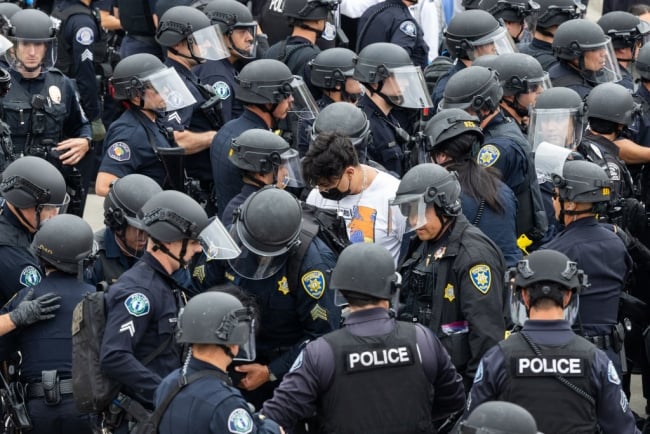You have /5 articles left.
Sign up for a free account or log in.

A pro-Palestinian demonstrator was arrested at University of California, Irvine May 15.
VCG/Contributor/Visual China Group/Getty Images
An elderly faculty member thrown to the ground, students handcuffed with zip-ties, flash-bang grenades and an errant gunshot popping off, police dressed up in riot gear storming campuses. One might think of Hong Kong at the end of the last decade or Iran in 2022. And while these places did in fact see this kind of repression play out in recent years, what I am describing is what has happened on college campuses over the past month in the United States. It is not a good look for a country that likes to call itself “a beacon to the world” as President Biden said last fall at the White House. If we’re a beacon now, we’re more like a flashing light of warning: how could what historian Adam Tooze called “the state as blunt force” be unleashed on 20-somethings and their teachers nationwide right here at home?
As the chronicler of American conservatism, Rick Perlstein, has noted, the provocations for this kind of response are far milder than what drew police and the National Guard onto college campuses in the 1960s. The protests of 2024 are notably peaceful compared to what unfolded back then. Yet, college presidents egged on by their own trustees, donors, and local and national politicians have decided on campus after campus to bring the hammer down over the past few weeks. Beyond the initial raids on student encampments, universities are expelling or suspending students, and even requiring the writing of penitential essays to reflect on their misdeeds.
For all the talk of universities as bastions of woke progressivism from some, what is playing out doesn’t look very progressive to those of us watching this in real time in academia. In fact, those on the right are elated about the crackdowns, even as they have previously moaned about intolerance for conservative views on campuses. I guess tolerance for me, not for thee is the ruling mantra of the day. Given the game plan of people like Christopher Rufo and Elise Stefanik—to bring universities to heel as part of their political agenda—it’s not surprising to see their celebration of this moment.
But what draws people from the mainstream of American political life and the media—including President Biden and the editorial board of The New York Times—to sidle up in solidarity to these conservative perspectives, charging the protesters with fomenting violence and chaos even as independent observers, such as the Armed Conflict Location & Event Data Project (ACLED) and the Crowd Counting Consortium challenged this narrative and characterized the protests as “overwhelmingly peaceful” and decidedly not violent? Why is there scant mention of the escalation of tensions due to police presence, the outright violence meted out on students and faculty by law enforcement, as they invoke the need for law and order to be restored?
It is a bit of a mystery. Even if these politicians and pundits disagree with the aims of the protests, are convinced despite facts to the contrary that these demonstrations are cesspools of antisemitism, the support for the use of force here seems disproportionate at least and has been shown to be absolutely avoidable by those leaders who simply refused to take the bait and have managed the protests on their own terms.
One might suggest that as we see much of the world slide to the right, and see the specter of authoritarianism on the rise here in the United States, many are “obey[ing] in advance,” as my Yale University colleague Tim Snyder has suggested happens in the face of tyranny in other times, other places. If you are attuned to the ways the political winds are blowing, showing that “law and order” trumps dissent and protest under your own watch could serve as a talisman to ward off threats to your own future. No university president wants to end up like Claudine Gay at Harvard University or Liz Magill at the University of Pennsylvania. For those in the media who want to be able to function even under a right-wing government, showing some early fealty to conservative concerns may function similarly, as a sign of acquiescence to the realpolitik of the moment. For the White House? Sheer expediency is likely at work as they seek to fend off criticism from the Trump campaign and its surrogates, even if means throwing students under the bus as they trumpet their loan-forgiveness initiatives.
Of course, the worst-case scenario here is that no one is being compelled to send in the cops on students and faculty and that the vision of university presidents, newspaper editors and our current president are aligned around repression of dissent as the first and best response to what is happening on our campuses. As politicians like J.D. Vance look to Hungary’s attacks on higher education as a model for the U.S., what we’re seeing now may indicate that we’ve already started down that very dangerous road. That should frighten us all as it makes the future ahead look very bleak indeed.




